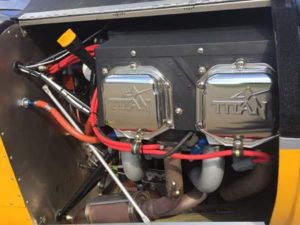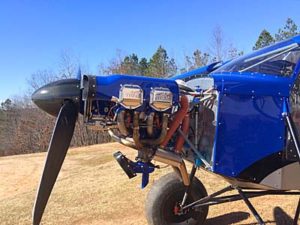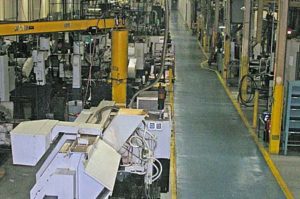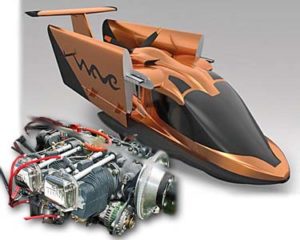Coming up in just over two weeks! — September 8-9-10, 2016 — is the Midwest LSA Expo. I hope your plans include going. Plenty of aircraft are available and taking a demo flight is no easier anywhere. I will look for you on site! More info: Midwest LSA Expo.

A Titan X-340 engine installed in American Legend‘s SuperCub.
Engines have changed a lot over the life of Light-Sport Aircraft. FAA’s new regulation became effective in September 2004. A hard working industry has brought 140 Special LSA models to market …in less than 12 years, one per month for every month (on average) since the rule emerged.
Engines have been similarly prolific.
In the beginning, Rotax‘s 65-horsepower two-stroke 582 was a often selected to power the lighter aircraft of the pre-LSA period. The 9-series engines had gained acceptance much earlier but as LSA got bigger and heavier, their success gave a tremendous push to the popular Austrian engine and it dominates to this day. The 100-horsepower 912 ULS and iS models are used on around 75% of all LSA-like aircraft worldwide. The larger 915 model to arrive in 2017 will surely continue the Austrian company’s success story.
However, while Rotax is the biggest player, many others have found acceptance.

Titan will power the already-awesome Just Aircraft SuperSTOL.
I envision three categories of light aircraft engines: Alternative, Mainline, and Emerging. In the Alternative category, we have a variety of two-stroke engines and very small four-strokes. Early on, Rotax owned this category, too, with their 277, 377, 447, and 503 two-stroke engines, the latter of which was particularly well regarded. All have since been discontinued though many are available on the used market. Hirth remains active with a whole line of two-stroke engines.
If we include engines for powered paragliders and very light trikes, some wonderful small powerplant are available: Bailey — I came to enjoy this tiny, fuel-efficient, moderately-quiet four-stroke engine; see article — plus Simonini, Polini, Vittorazi, and others (article) lift the very lightest of powered aircraft.
Delving still deeper into alternative engines brings us to electric, solar electric, and hybrid electric. Then we have diesel. I have examined and reported on more than I care to mention here but the fact is, choices are ample.
Nonetheless the Mainline category has the most recognized brands: Rotax’s 9-series is flanked by Jabiru‘s 2200 and 3300 models, Continental’s popular O-200, the LSA-specific Lycoming O-233, plus others like UL Power and D-Motor are reportedly working on ASTM compliance but meanwhile are used to power homebuilt and other aircraft in growing numbers. For kit builders, auto conversions from companies like Viking and Aero Momentum among others can save money while offering impressive hardware built from recognized brands such as Honda and Suzuki.

Continental’s factory floor in Mobile, Alabama is a vast facility, used to make engines since back to World War II.
Now coming to the Emerging category, we have models like the Titan with its whopping 180 horsepower. Photos with this article show several adaptations and I expect more. As well, Rotax’s 135-horsepower will find a market for more power.
As reported earlier, Continental acquired ECi, originator of the X-340 Titan. For a time, they functioned as sibling but separate companies. Now, the Alabama powerhouse is consolidating.
On August 17, 2016 Continental Motors Group (CMG) announced that it “will consolidate all manufacturing operations into its advanced manufacturing centers located Alabama and Germany.” This change is sweeping. “The manufacture of CMG’s line of FAA approved parts for Lycoming engines, as well as the full line of Titan Experimental and Certified engines that are currently produced in CMG’s San Antonio, Texas facility will be transferred as a result of this consolidation.”
CMG said it has “invested significantly in advanced manufacturing equipment, processes and people while implementing manufacturing techniques and lean tools based on the Toyota Production System.” Because CMG and ECi used similar processes to make similar parts and assemblies, relocating the products currently produced in San Antonio makes sense, the company explained.

Vickers Aircraft Wave, expected in 2017, will be the first LSA seaplane to employ the 180-horsepower Titan X-340 engine.
“Continental Motors has grown significantly in the past three years in both products and facilities as we strive to become the leader in propulsion for small aircraft,” said CEO Rhett Ross. “However, as we have seen our business grow in the number of products, customers and operating sites, it has become apparent that changes are needed to make us more responsive to the needs of our customers.
CMG will coordinate with its Master Distributor, Aviall, to complete this move without interrupting the availability of the high quality, factory produced parts and engines within the Titan Product Family.
Continental wished to recognize the valuable contributions made by ECi employees in San Antonio. CMG promised to help those employees transition to new roles within the Continental family or to find new opportunities within the San Antonio business community. Customers or airframe manufacturers with questions may direct them to marketing boss Emmanuel Davidson.



Leave a Reply